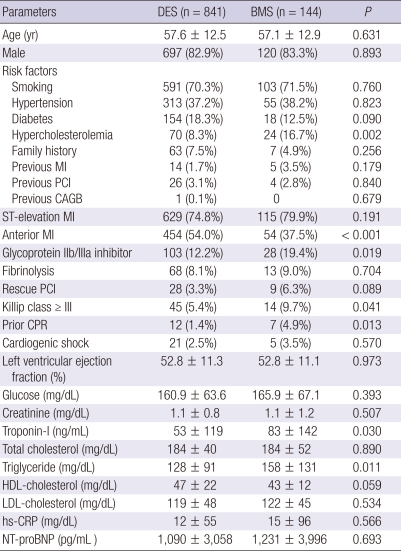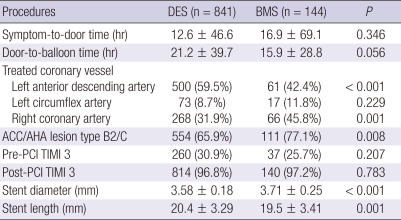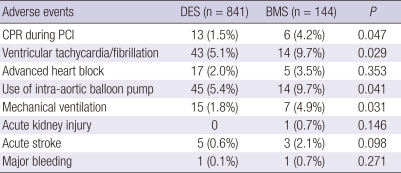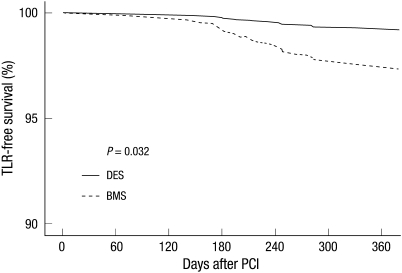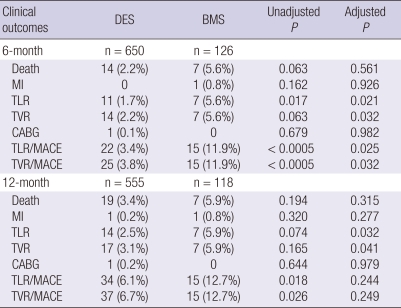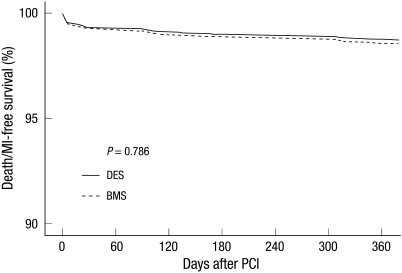Abstract
This study compared clinical outcomes of drug-eluting stents (DES) versus bare-metal stents (BMS) in large coronary arteries in patients with acute myocardial infarction (MI). A total of 985 patients who underwent single-vessel percutaneous coronary intervention (PCI) in large coronary arteries (≥ 3.5 mm) in lesions < 25 mm were divided into DES group (n = 841) and BMS group (n = 144). Clinical outcomes during 12 months were compared. In-hospital outcome was similar between the groups. At six months, death/MI rate was not different. However, DES group had significantly lower rates of target-lesion revascularization (TLR) (1.7% vs 5.6%, P = 0.021), target-vessel revascularization (TVR) (2.2% vs 5.6%, P = 0.032), and total major adverse cardiac events (MACE) (3.4% vs 11.9%, P = 0.025). At 12 months, the rates of TLR and TVR remained lower in the DES group (2.5% vs 5.9%, P = 0.032 and 5.9% vs 3.1%, P = 0.041), but the rates of death/MI and total MACE were not statistically different. The use of DES in large vessels in the setting of acute MI is associated with lower need for repeat revascularization compared to BMS without compromising the overall safety over the course of one-year follow-up.
Keywords: Myocardial Infarction, Drug-Eluting Stents
INTRODUCTION
Vessel size is an important risk predictor of clinical and angiographic outcomes in patients undergoing percutaneous coronary intervention (PCI) (1, 2). Small reference diameter has been associated with an increased risk of restenosis. In patients treated with bare-metal stents (BMS), the impact of vessel size is quite obvious because of the limited ability of small size vessels to accommodate to the neointimal proliferation that develops after stent implantation (2, 3). Drug-eluting stents (DES) are effective in reducing restenosis risk compared with BMS in patients with coronary artery disease (4-6). The advantages of DES over BMS have been shown in different subsets of patients and lesions, including that of small coronary vessels (7-9). The anti-restenotic efficacy of DES is achieved through inhibition of neointimal proliferation, which is shown angiographically by the reduced degree of late lumen loss (4).
Nevertheless, the superiority of DES over BMS for the treatment of large vessels in patients undergoing high-risk PCI such as in the setting of acute myocardial infarction (MI) has yet to be defined. We investigated the safety and effectiveness of DES versus BMS in large coronary vessels in patients with acute MI during 12-month clinical follow-up.
MATERIALS AND METHODS
Patient population
We analyzed data of patients with acute MI who were enrolled in the Korea Acute Myocardial Infarction Registry (10, 11) between November 2005 and December 2007. Patients, entered into the registry, were ≥ 18 yr of age at the time of hospital presentation, had to be admitted for an acute MI as a presumptive diagnosis, and have ≥ 1 of the followings: electrocardiographic changes consistent with an acute MI, serial increases in serum biochemical markers of myocardial necrosis, and/or documentation of coronary artery disease. A total of 1,340 patients with acute MI who underwent single-vessel PCI with stents ≥ 3.5 mm in diameter were selected and divided into two groups (group 1, patients who received DES, n = 1,151; and group 2, patients who underwent BMS implantation, n = 189). Given that lesion length is also recognized as a predictor of recurrent restenosis, only the patients who received stents < 25 mm were included in the analysis. Three different DES were used: sirolimus-eluting stents (Cypher stent, Cordis, Johnson & Johnson, Miami, FL, USA) in 347 patients, paclitaxel-eluting stents (Taxus stent, Boston Scientific, Natick, MA, USA) in 284 patients, and zotarolimus-eluting stents (Endeavor Sprint stent, Medtronic, Minneapolis, MN, USA) in 210 patients. Although BMS were available in a variety of large diameters, only those ≤ 4.0 mm were included in the present study.
PCI procedure and medications
Stent implantation was performed with standard interventional techniques. Before the procedure, all patients received orally 300 mg of aspirin and 300 to 600 mg of clopidogrel. During the procedure, weight-adjusted unfractionated heparin was given at a bolus dose of 100 U/kg with additional bolus to maintain activated clotting time of 250 to 300 sec. The use of other adjunctive medications, including glycoprotein IIb/IIIa inhibitors, was left to the discretion of the operator. After the procedure, 100 to 300 mg/day of aspirin was continued indefinitely, and 75 mg/day of clopidogrel was maintained for at least 4 weeks in patients with BMS and for ≥ 12 months in patients with DES. Baseline clinical characteristics, angiographic features, in-hospital mortality, and clinical outcomes at follow-up were recorded and entered into a dedicated computerized database.
Study definitions and endpoints
A large coronary vessel was defined as ≥ 3.5 mm in diameter. Angiographic success was defined as < 25% diameter residual stenosis with Thrombolysis In Myocardial Infarction (TIMI) grade 3 flow. Clinical success was defined as angiographic success without in-hospital complications of death, MI, or coronary artery bypass graft within 24 hr of the index procedure. Major adverse cardiac events (MACE) included death, MI, and need for repeat target-lesion revascularization (TLR) or target-vessel revascularization (TVR). TLR was defined as a repeat intervention (surgical or percutaneous) to control luminal stenosis within the same vessel segment that was treated at the index procedure. TVR was defined as any reintervention driven by lesions located in the treated vessel within and beyond the target lesion limits. Non-TVR was defined as any reintervention in vessels other than the target vessel. Smoking was defined as any history of tobacco smoking. Hypertension was defined as a history of hypertension or antihypertensive medication use, and diabetes was defined as a history of diabetes and use of insulin or oral hypoglycemic agents on entry into the study. Hypercholesterolemia was defined as a diagnosis previously made by a physician or by treatment with lipid-lowering medications. Lesion length and vessel reference diameter were visually estimated by the operators. On-line quantitative coronary analysis was allowed if required by the attending physician. Study endpoints were in-hospital complications including death, MI, bleeding complications, vascular complications, and the composite end point of MACE, including death, MI, and TLR or TVR. Clinical follow-up with respect to MACE occurred again at 30 days, 6 months and 12 months after the baseline procedure.
Statistical analysis
All statistical analyses were performed with SPSS 15.0 for Windows (SPSS Inc.). Continuous variables were presented as mean ± SD and were compared by Student t test (when the group distributions were symmetrical and mounded) or Mann-Whitney U test (when the group distributions were skewed). The chi-square test (when all expected cell counts were ≥ 5) or Fisher exact test (when any expected cell count was < 5) was used to determine the significance of differences in categorical variables. Multivariable survival analysis was performed by a Cox-regression model. All statistical tests were two-tailed, and a P value < 0.05 was considered statistically significant. To assess selection bias not controlled for in our multivariate model, we used a propensity-adjustment model. We developed propensity scores based on the likelihood of receiving DES derived from a logistic regression model incorporating 31 variables: age, sex, hypertension, diabetes, smoking, hyperlipidemia, previous MI, previous PCI, previous coronary artery bypass graft surgery, family history of MI, treated vessel, American College of Cardiology/American Heart Association lesion type, pre-PCI TIMI flow, stent size, stent diameter, ST-elevation MI, anterior MI, cardiogenic shock, prior cardiopulmonary resuscitation (CPR), fibrinolysis, ventricular tachycardia/fibrillation, advanced heart block (Mobitz type II or III), rescue PCI, intra-aortic balloon pump counterpulsation, mechanical ventilation, use of glycoprotein IIb/IIIa receptor inhibitor, Killip class III or IV, left ventricular ejection fraction, symptom-to-door time, and door-to-balloon time (C-statistic = 0.768). We incorporated the resultant propensity scores into a logistic regression model to negate selection bias in examining the effect of propensity for DES use on clinical outcome.
Ethics statement
The study was conducted according to the Declaration of Helsinki. The institutional review board of all participating centers approved the study protocol. The approval number was 05-49 of Chonnam National University Hospital. Written informed consent was obtained from all participating patients.
RESULTS
The baseline clinical and procedural characteristics are displayed in Tables 1, 2. Patients who received BMS were more likely to have hypercholesterolemia, Killip class > III, prior CPR, higher troponin and triglyceride levels, the right coronary artery as the culprit vessel, and more complex lesion types. They were more likely to receive stents with larger diameters and shorter lengths and to be treated with glycoprotein IIb/IIIa inhibitors during the PCI. In contrast, cilostazol was more likely to be used in the DES group compared to the BMS group after PCI (37.8% vs 16.7%, P < 0.001). BMS group was more likely to be associated with adverse peri-procedural events (Table 3). In-hospital and 30-day outcomes are presented in Table 4. Mortality in-hospital and at 30 days were not different between the groups after controlling for confounding variables using propensity scores. At six-month follow-up, patients with DES had significantly lower rates of TLR (1.7% vs 5.6%, P = 0.021), TVR (2.2% vs 5.6%, P = 0.032), and combined MACE, which were mainly driven by lower TLR/TVR (Fig. 1, Table 5). At 12 months, the rates of TLR and TVR remained significantly lower in patients with DES (2.5% vs 5.9%, P = 0.032 and 3.1% vs 5.9%, P = 0.041, respectively). However, 12-month death/MI rates and composite MACE rates were not significantly different between the groups (Fig. 2, Table 5).
Table 1.
Baseline clinical characteristics of the study population
CABG, coronary artery bypass grafting; CPR, cardiopulmonary resuscitation; HDL, high-density lipoprotein; hs-CRP, high-sensitivity C-reactive protein; LDL, low-density lipoprotein; NT-proBNP, N-terminal pro-B-type natriuretic peptide; PCI, percutaneous coronary intervention.
Table 2.
Procedural characteristics of the study population
ACC/AHA, American College of Cardiology/American Heart Association; PCI, percutaneous coronary intervention; TIMI, Thrombolysis in Myocardial Infarction.
Table 3.
Frequeneis of peri-procedural adverse events
CPR, cardiopulmonary resuscitation; PCI, percutaneous coronary intervention.
Table 4.
In-hospital mortality and 30-day clinical outcomes
MI, myocardial infarction; TLR, target lesion revascularization; TVR, target vessel revascularization; CABG, coronary artery bypass graft surgery; MACE, major adverse cardiac events.
Fig. 1.
Target lesion revascularization (TLR)-free survival at 12 months. BMS, bare-metal stents; DES, drug-eluting stents; PCI, percutaneous coronary intervention.
Table 5.
Six- and 12-month clinical outcomes
MI, myocardial infarction; TLR, target lesion revascularization; TVR, target vessel revascularization; CABG, coronary artery bypass graft surgery; MACE, major adverse cardiac events.
Fig. 2.
Death/MI-free survival at 12 months. TLR, target lesion revascularization; BMS, bare-metal stents; DES, drug-eluting stents; PCI, percutaneous coronary intervention.
DISCUSSION
The present study showed that the use of DES in large single culprit vessels in patients with acute MI was associated with significantly lower rates of TLR and TVR without increasing the rates of death/MI or composite MACE during a one-year clinical follow-up. This finding demonstrated that the important advantage of a lower restenosis rate with DES relative to BMS existed for PCI even in large vessels in the setting of acute MI.
DES are now used in preference to BMS in most PCI procedures because they reduce the incidence of restenosis and TVR without causing a significant increase in the cumulative rate of adverse outcomes. Recently, DES have been increasingly used even in patients with acute MI. Most randomized trials, which evaluated outcomes at one year or less, suggested that the benefit of DES relative to BMS used for PCI in acute MI patients was similar to that in other settings (12-17). Longer-term outcomes were also similar between DES to BMS (18-22). The majority of the studies found a lower rate of TVR in DES group without increasing death or MI at two to three years' follow-up. Furthermore, no statistically significant difference was observed in the rate of late stent thrombosis between DES and BMS at one to three years of follow-up (18, 21, 22).
While DES are clearly effective in reducing restenosis rates by inhibiting neointimal growth, data from a number of randomized trials and registries have shown conflicting results regarding their effectiveness in the treatment of large vessels. Most studies showed no differences between BMS and DES in clinical outcomes of PCI in large coronary vessels (5, 6, 8, 23-27). BMS in large (≥ 3.0-3.5 mm) vessels appeared as effective as DES with lower TLR at six months to three years. In the recent BASKET trial (28), the benefit of DES in reducing the rate of ischemia-driven TVR persisted up to three years, particularly in patients with small (< 3 mm) stents (P = 0.03), while being small and non-significant in patients with large (≥ 3.0 mm) stents (P = 0.44). However, the three-year cardiac death/MI rate was significantly higher in patients with large stents treated with DES due to increase in the rate of late stent thrombosis. This new observation from this trial implies that DES in large vessels are more prone to late stent thrombosis and therefore may paradoxically portend worse long-term clinical outcome compared to BMS. However, given that only 21 percent of the study population had acute MI and the study was underpowered to definitely assess the magnitude of late stent thrombosis, the long-term safety and benefit of DES in large vessels in patients with acute MI need to be evaluated in a larger prospective setting. In our study, there was no overall increase in the rates of the safety endpoints, i.e., death or death/MI, in the DES group compared with the BMS group, indicating lower incidence of late stent thrombosis in DES-treated patients, although stent thrombosis was not included as an endpoint in this study.
The present study is limited because of its retrospective nature and is therefore subject to the limitations pertinent to this type of clinical investigation. This study is not randomized and also lacks systematic angiographic follow-up and quantitative coronary analysis that seem to increase the rates of TLR and TVR. Stent thrombosis was not included as an endpoint in the present study. However, death/MI rate was not increased in DES compared to BMS over the 12-month period, suggesting that the rate of clinically relevant stent thrombosis would have been similar between the two groups. Still, longer follow-up is needed to see whether DES in large vessels are indeed associated with an increased incidence of late and very late stent thrombosis in patients with acute MI, which may then tip the scales in favor of BMS in this population. The difference in the sample size between the DES and BMS group needs to be taken into consideration in interpreting the data. Furthermore, even though we used propensity score to adjust for treatment selection bias regarding the use of DES during PCI for acute MI, unmeasured confounders may have influenced the results. For instance, the use of long-term medical therapies that have potential efficacy of reducing restenosis might have affected the outcome (29, 30). Finally, differences between the institutions involved in this research, although representative of the reality of the country's health system, may to some extent have introduced an unintentional bias.
In conclusion, our results show that the use of DES in large vessels in the setting of acute MI is associated with reduced need for repeat revascularization compared to BMS without compromising the overall safety over the course of one-year follow-up.
ACKNOWLEDGMENTS
Korea Acute Myocardial Infarction (KAMIR) Investigators: Myung Ho Jeong, MD, Young Keun Ahn, MD, Shung Chull Chae, MD, Jong Hyun Kim, MD, Seung Ho Hur, MD, Young Jo Kim, MD, In Whan Seong, MD, Dong Hoon Choi, MD, Jei Keon Chae, MD, Taek Jong Hong, MD, Jae Young Rhew, MD, Doo Il Kim, MD, In Ho Chae, MD, Jung Han Yoon, MD, Bon Kwon Koo, MD, Byung Ok Kim, MD, Myoung Yong Lee, MD, Kee Sik Kim, MD, Jin Yong Hwang, MD, Myeong Chan Cho, MD, Seok Kyu Oh, MD, Nae Hee Lee, MD, Kyoung Tae Jeong, MD, Seung Jea Tahk, MD, Jang Ho Bae, MD, Seung Woon Rha, MD, Keum Soo Park, MD, Chong Jin Kim, MD, Kyoo Rok Han, MD, Tae Hoon Ahn, MD, Moo Hyun Kim, MD, Ki Bae Seung, MD, Wook Sung Chung, MD, Ju Young Yang, MD, Chong Yun Rhim, MD, Hyeon Cheol Gwon, MD, Seong Wook Park, MD, Young Youp Koh, MD, Seung Jae Joo, MD, Soo Joong Kim, MD, Dong Kyu Jin, MD, Jin Man Cho, MD, Yang Soo Jang, MD, Jeong Gwan Cho, MD, and Seung Jung Park, MD.
Footnotes
This study was performed with the support of the Korean Circulation Society (KCS) in commemoration of its 50th anniversary.
AUTHOR SUMMARY
Effectiveness of Drug-Eluting Stents versus Bare-Metal Stents in Large Coronary Arteries in Patients with Acute Myocardial Infarction
Doo Sun Sim, Myung Ho Jeong, Youngkeun Ahn, Young Jo Kim, Shung Chull Chae, Taek Jong Hong, In Whan Seong, Jei Keon Chae, Chong Jin Kim, Myeong Chan Cho, Ki Bae Seung, Seung Jung Park, and other Korea Acute Myocardial Infarction Registry (KAMIR) Investigators
Total of 985 patients who underwent single-vessel percutaneous coronary intervention (PCI) in large coronary arteries (≥ 3.5 mm) in lesions < 25 mm were divided into DES group (n = 841) and BMS group (n = 144) over the course of one-year follow-up. The use of drug-eluting stent for acute myocardial infarction is, without compromising the overall safety, associated with lower need for repeated revascularization than bare metal stent.
References
- 1.Kastrati A, Schömig A, Elezi S, Schühlen H, Dirschinger J, Hadamitzky M, Wehinger A, Hausleiter J, Walter H, Neumann FJ. Predictive factors of restenosis after coronary stent placement. J Am Coll Cardiol. 1997;30:1428–1436. doi: 10.1016/s0735-1097(97)00334-3. [DOI] [PubMed] [Google Scholar]
- 2.Elezi S, Kastrati A, Neumann FJ, Hadamitzky M, Dirschinger J, Schömig A. Vessel size and long-term outcome after coronary stent placement. Circulation. 1998;98:1875–1880. doi: 10.1161/01.cir.98.18.1875. [DOI] [PubMed] [Google Scholar]
- 3.Agostoni P, Biondi-Zoccai GG, Gasparini GL, Anselmi M, Morando G, Turri M, Abbate A, McFadden EP, Vassanelli C, Zardini P, Colombo A, Serruys PW. Is bare-metal stenting superior to balloon angioplasty for small vessel coronary artery disease? Evidence from a meta-analysis of randomized trials. Eur Heart J. 2005;26:881–889. doi: 10.1093/eurheartj/ehi116. [DOI] [PubMed] [Google Scholar]
- 4.Regar E, Serruys PW, Bode C, Holubarsch C, Guermonprez JL, Wijns W, Bartorelli A, Constantini C, Degertekin M, Tanabe K, Disco C, Wuelfert E, Morice MC RAVEL Study Group. Angiographic findings of the multicenter Randomized Study With the Sirolimus-Eluting Bx Velocity Balloon-Expandable Stent (RAVEL): sirolimus-eluting stents inhibit restenosis irrespective of the vessel size. Circulation. 2002;106:1949–1956. doi: 10.1161/01.cir.0000034045.36219.12. [DOI] [PubMed] [Google Scholar]
- 5.Moses JW, Leon MB, Popma JJ, Fitzgerald PJ, Holmes DR, O'Shaughnessy C, Caputo RP, Kereiakes DJ, Williams DO, Teirstein PS, Jaeger JL, Kuntz RE SIRIUS Investigators. Sirolimus-eluting stents versus standard stents in patients with stenosis in a native coronary artery. N Engl J Med. 2003;349:1315–1323. doi: 10.1056/NEJMoa035071. [DOI] [PubMed] [Google Scholar]
- 6.Stone GW, Ellis SG, Cox DA, Hermiller J, O'Shaughnessy C, Mann JT, Turco M, Caputo R, Bergin P, Greenberg J, Popma JJ, Russell ME TAXUS-IV Investigators. A polymer-based, paclitaxel-eluting stent in patients with coronary artery disease. N Engl J Med. 2004;350:221–231. doi: 10.1056/NEJMoa032441. [DOI] [PubMed] [Google Scholar]
- 7.Dawkins KD, Grube E, Guagliumi G, Banning AP, Zmudka K, Colombo A, Thuesen L, Hauptman K, Marco J, Wijns W, Popma JJ, Koglin J, Russell ME TAXUS VI Investigators. Clinical efficacy of polymer-based paclitaxel-eluting stents in the treatment of complex, long coronary artery lesions from a multicenter, randomized trial: support for the use of drug-eluting stents in contemporary clinical practice. Circulation. 2005;112:3306–3313. doi: 10.1161/CIRCULATIONAHA.105.552190. [DOI] [PubMed] [Google Scholar]
- 8.Stone GW, Ellis SG, Cannon L, Mann JT, Greenberg JD, Spriggs D, O'Shaughnessy CD, DeMaio S, Hall P, Popma JJ, Koglin J, Russell ME TAXUS V Investigators. Comparison of a polymer-based paclitaxel-eluting stent with a bare metal stent in patients with complex coronary artery disease: a randomized controlled trial. JAMA. 2005;294:1215–1223. doi: 10.1001/jama.294.10.1215. [DOI] [PubMed] [Google Scholar]
- 9.Ardissino D, Cavallini C, Bramucci E, Indolfi C, Marzocchi A, Manari A, Angeloni G, Carosio G, Bonizzoni E, Colusso S, Repetto M, Merlini PA SES-SMART Investigators. Sirolimus-eluting vs. uncoated stents for prevention of restenosis in small coronary arteries: a randomized trial. JAMA. 2004;292:2727–2734. doi: 10.1001/jama.292.22.2727. [DOI] [PubMed] [Google Scholar]
- 10.Sim DS, Kim JH, Jeong MH. Differences in clinical outcomes between patients with ST-elevation versus non-ST-elevation acute myocardial infarction in Korea. Korean Circ J. 2009;39:297–303. doi: 10.4070/kcj.2009.39.8.297. [DOI] [PMC free article] [PubMed] [Google Scholar]
- 11.Sim DS, Jeong MH, Kang JC. Current management of acute myocardial infarction: experience from the Korea Acute Myocardial Infarction Registry. J Cardiol. 2010;56:1–7. doi: 10.1016/j.jjcc.2010.04.002. [DOI] [PubMed] [Google Scholar]
- 12.Moses JW, Mehran R, Nikolsky E, Lasala JM, Corey W, Albin G, Hirsch C, Leon MB, Russell ME, Ellis SG, Stone GW. Outcomes with the paclitaxel-eluting stent in patients with acute coronary syndromes: analysis from the TAXUS-IV trial. J Am Coll Cardiol. 2005;45:1165–1171. doi: 10.1016/j.jacc.2004.10.074. [DOI] [PubMed] [Google Scholar]
- 13.Spaulding C, Henry P, Teiger E, Beatt K, Bramucci E, Carrié D, Slama MS, Merkely B, Erglis A, Margheri M, Varenne O, Cebrian A, Stoll HP, Snead DB, Bode C TYPHOON Investigators. Sirolimus-eluting versus uncoated stents in acute myocardial infarction. N Engl J Med. 2006;355:1093–1104. doi: 10.1056/NEJMoa062006. [DOI] [PubMed] [Google Scholar]
- 14.Valgimigli M, Percoco G, Malagutti P, Campo G, Ferrari F, Barbieri D, Cicchitelli G, McFadden EP, Merlini F, Ansani L, Guardigli G, Bettini A, Parrinello G, Boersma E, Ferrari R STRATEGY Investigators. Tirofiban and sirolimus-eluting stent vs. abciximab and bare-metal stent for acute myocardial infarction: a randomized trial. JAMA. 2005;293:2109–2117. doi: 10.1001/jama.293.17.2109. [DOI] [PubMed] [Google Scholar]
- 15.Menichelli M, Parma A, Pucci E, Fiorilli R, De Felice F, Nazzaro M, Giulivi A, Alborino D, Azzellino A, Violini R. Randomized trial of sirolimus-eluting stent versus bare-metal stent in acute myocardial infarction (SESAMI) J Am Coll Cardiol. 2007;49:1924–1930. doi: 10.1016/j.jacc.2007.01.081. [DOI] [PubMed] [Google Scholar]
- 16.Kelbaek H, Thuesen L, Helqvist S, Clemmensen P, Kløvgaard L, Kaltoft A, Andersen B, Thuesen H, Engstrøm T, Bøtker HE, Saunamäki K, Krusell LR, Jørgensen E, Hansen HH, Christiansen EH, Ravkilde J, Køber L, Kofoed KF, Terkelsen CJ, Lassen JF DEDICATION Investigators. Drug-eluting versus bare metal stents in patients with ST-segment-elevation myocardial infarction: eight-month follow-up in the Drug Elution and Distal Protection in Acute Myocardial Infarction (DEDICATION) trial. Circulation. 2008;118:1155–1162. doi: 10.1161/CIRCULATIONAHA.107.758698. [DOI] [PubMed] [Google Scholar]
- 17.Stone GW, Lansky AJ, Pocock SJ, Gersh BJ, Dangas G, Wong SC, Witzenbichler B, Guagliumi G, Peruga JZ, Brodie BR, Dudek D, Möckel M, Ochala A, Kellock A, Parise H, Mehran R HORIZONS-AMI Trial Investigators. Paclitaxel-eluting stents versus bare-metal stents in acute myocardial infarction. N Engl J Med. 2009;360:1946–1959. doi: 10.1056/NEJMoa0810116. [DOI] [PubMed] [Google Scholar]
- 18.Valgimigli M, Campo G, Arcozzi C, Malagutti P, Carletti R, Ferrari F, Barbieri D, Parrinello G, Percoco G, Ferrari R. Two-year clinical follow-up after sirolimus-eluting versus bare-metal stent implantation assisted by systematic glycoprotein IIb/IIIa inhibitor infusion in patients with myocardial infarction: results from the STRATEGY study. J Am Coll Cardiol. 2007;50:138–145. doi: 10.1016/j.jacc.2007.04.029. [DOI] [PubMed] [Google Scholar]
- 19.Mauri L, Silbaugh TS, Garg P, Wolf RE, Zelevinsky K, Lovett A, Varma MR, Zhou Z, Normand SL. Drug-eluting or bare-metal stents for acute myocardial infarction. N Engl J Med. 2008;359:1330–1342. doi: 10.1056/NEJMoa0801485. [DOI] [PubMed] [Google Scholar]
- 20.Di Lorenzo E, Sauro R, Varricchio A, Carbone G, Cortese G, Capasso M, Lanzillo T, Manganelli F, Mariello C, Siano F, Pagliuca MR, Stanco G, Rosato G, De Luca G. Long-term outcome of drug-eluting stents compared with bare metal stents in ST-segment elevation myocardial infarction: results of the paclitaxel- or sirolimus-eluting stent versus bare metal stent in Primary Angioplasty (PASEO) Randomized Trial. Circulation. 2009;120:964–972. doi: 10.1161/CIRCULATIONAHA.108.830372. [DOI] [PubMed] [Google Scholar]
- 21.Anderson HV, Smalling RW, Henry TD. Drug-eluting stents for acute myocardial infarction. J Am Coll Cardiol. 2007;49:1931–1933. doi: 10.1016/j.jacc.2007.03.002. [DOI] [PubMed] [Google Scholar]
- 22.Brar SS, Leon MB, Stone GW, Mehran R, Moses JW, Brar SK, Dangas G. Use of drug-eluting stents in acute myocardial infarction: a systematic review and meta-analysis. J Am Coll Cardiol. 2009;53:1677–1689. doi: 10.1016/j.jacc.2009.03.013. [DOI] [PubMed] [Google Scholar]
- 23.Hoffmann R, Mintz GS. Coronary in-stent restenosis - predictors, treatment and prevention. Eur Heart J. 2000;21:1739–1749. doi: 10.1053/euhj.2000.2153. [DOI] [PubMed] [Google Scholar]
- 24.Stone GW, Ellis SG, Cox DA, Hermiller J, O'Shaughnessy C, Mann JT, Turco M, Caputo R, Bergin P, Greenberg J, Popma JJ, Russell ME TAXUS-IV Investigators. One-year clinical results with slow-release, polymer-based, paclitaxel-eluting TAXUS stent: TAXUS-IV trial. Circulation. 2004;109:1942–1947. doi: 10.1161/01.CIR.0000127110.49192.72. [DOI] [PubMed] [Google Scholar]
- 25.Steinberg DH, Mishra S, Javaid A, Slottow TL, Buch AN, Roy P, Okabe T, Smith KA, Torguson R, Xue Z, Pichard AD, Satler LF, Kent KM, Suddath WO, Waksman R. Comparison of effectiveness of bare metal stents versus drug-eluting stents in large (> or =3.5 mm) coronary arteries. Am J Cardiol. 2007;99:599–602. doi: 10.1016/j.amjcard.2006.09.105. [DOI] [PubMed] [Google Scholar]
- 26.Quizhpe AR, Feres F, de Ribamar Costa J, Jr, Abizaid A, Maldonado G, Costa R, Abizaid A, Cano M, Moreira AC, Staico R, Mattos LA, Tanajura LF, Chaves A, Centemero M, Sousa AM, Sousa JE. Drug-eluting stents vs. bare metal stents for the treatment of large coronary vessels. Am Heart J. 2007;154:373–378. doi: 10.1016/j.ahj.2007.04.027. [DOI] [PubMed] [Google Scholar]
- 27.Na JO, Kim JW, Choi CU, Choi UJ, Shin SY, Lim HE, Kim EJ, Rha SW, Park CG, Seo HS, Oh DJ. Bare-metal stents versus drug-eluting stents in large (≥ 3.5 mm) single coronary artery: Angiographic and clinical outcomes at 6 months. J Cardiol. 2009;54:108–114. doi: 10.1016/j.jjcc.2009.05.004. [DOI] [PubMed] [Google Scholar]
- 28.Pfisterer M, Brunner-La Rocca HP, Rickenbacher P, Hunziker P, Mueller C, Nietlispach F, Leibundgut G, Bader F, Kaiser C BASKET. Long-term benefit-risk balance of drug-eluting vs. bare-metal stents in daily practice: does stent diameter matter? Three-year follow-up of BASKET. Eur Heart J. 2009;30:16–24. doi: 10.1093/eurheartj/ehn516. [DOI] [PubMed] [Google Scholar]
- 29.Schömig A, Kastrati A, Wessely R. Prevention of restenosis by systemic drug therapy: back to the future? Circulation. 2005;112:2759–2761. doi: 10.1161/CIRCULATIONAHA.105.583484. [DOI] [PubMed] [Google Scholar]
- 30.Cho JS, Jeong MH, Sim DS, Hong YJ, Lim KS, Kim JH, Kim HD, Baek JY, Yoon HJ, Her SH, Jin SW, Kim JH, Ahn Y, Cho JG, Park JC, Kang JC. Effects of combined therapy with ezetimibe plus simvastatin after drug-eluting stent implantation in a porcine coronary restenosis model. J Korean Med Sci. 2010;25:716–722. doi: 10.3346/jkms.2010.25.5.716. [DOI] [PMC free article] [PubMed] [Google Scholar]



